The Most Hellish Place on Earth Contender #1: The Atacama Desert
It's the norm for people from places with difficult weather to brag about how awful it is to live in their home. (I still complain about Kansas, despite not having lived there in almost four years.) Over the next few posts, I'm going to be going over the actual serious contenders, though. At the end, I'll be having a vote to determine what people think the actual worst place is. Our first contender? The Atacama Desert in South America.
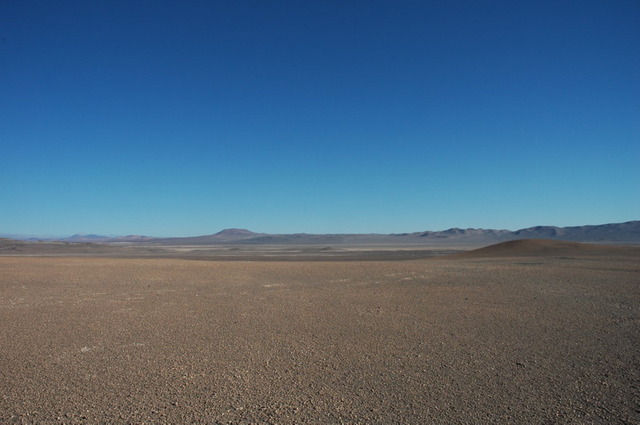
The Atacama Desert [Image source]
Nothing- and I mean nothing- lives in the heart of the Atacama desert. No plants, no animals, no lichens, no fungus. The Saharan ants that @mobbs talks about in his recent post might be incredibly well for the Sahara, but the Atacama would chew them up and spit them out. There aren't even any bacteria in much of the soil in the heart of the Atacama. We've actually used the tests we use to detect life on our Martian probes in the Atacama, and nothing. (Of course, we might be using the wrong tests.)
There's some life out in the borders and gentler areas of the Atacama, but even those gentle borderlands are harsh by the standards of nearly any other place on the planet. We've found two species of ants (Solenopsis gayi and Camponotus morosus) that have actually come to share nests and not only tolerate each other but work together to live in these harsh environments, each contributing their own strengths- and ants of different species never cooperate. The only historical cultures to live there were fishermen surviving almost entirely off the bounty of the sea.
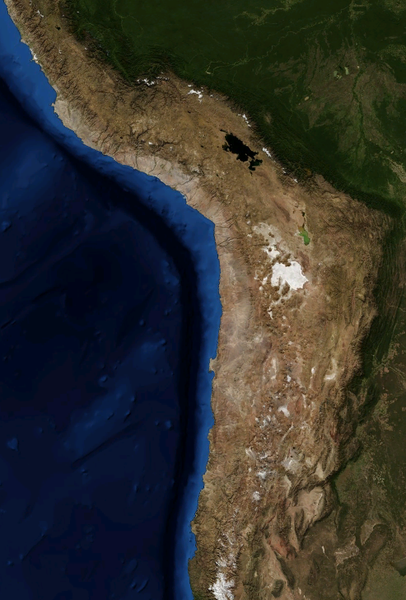
The extent of the Atacama desert. [Image source]
Why's it so hellish? First off, it's dry. Extremely dry. In fact, it's the single driest area of the planet outside the polar regions. It's 50 times drier than Death Valley, getting an average of less than 2 mm of precipitation per year. There's no evidence of any significant rainfall between 1570 and 1971. Some weather stations in the Atacama have literally NEVER received rain. There's a number of mountains in the Atacama over 20,000 feet in height that utterly lack glaciers and snowcaps due to the aridity.
In fact, the only moisture that some of the wettest regions of the Atacama get are sea fogs. If you had to live somewhere in the Atacama, you'd want to pick these hilly, sea-fog watered regions, known as Lomas. They're still not particularly nice, but life can survive there. In fact, many of the lomas have species endemic just to them. It's a classic example of island biogeography in action, just like what I talked about in my recent post.
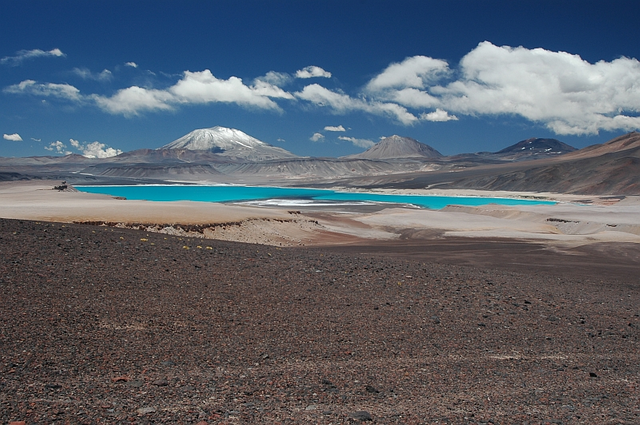
The lifeless salt lake Laguna Verde in front of a pair of volcanoes. [Image source]
The aridity, while by far the most severe issue confronting life in the Atacama, is far from the only threat facing life there. The temperatures have the normal extremes of heat and cold you expect from a desert, which is no laughing matter. The terrain is also harsh. There's little to no shade. Salt flats abound. You sometimes run across a pool of water in the middle of this desert, only to realize it's saltier than the Dead Sea. Much of the terrain you'll find yourself crossing are ancient felsic lava flows.
It's interesting, though- most harsh environments eventually develop life. So why hasn't the Atacama? The first thought that springs to mind is that it's a relatively young desert, and hasn't had time for life to evolve there. In fact, however, it's the oldest desert on the planet, at over three million years old. Parts of the desert may be as old as 200 million years old, dating back to the dawn of the Andes Mountains in the Jurassic. It seems that there's just a threshold of aridity beyond which life just can't really survive.
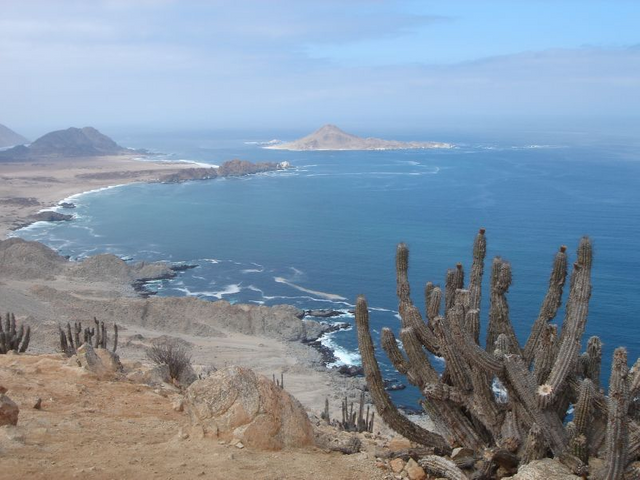
The lush Atacama seashore at Pan de Azucar National Park. [Image source]
What causes the aridity? The Atacama is trapped between the Andes mountain range and the Chilean coast range, fashioning one of the world's few double-sided rain shadows. In addition, the weather patterns created by the Humboldt current off the Pacific coast of South America tend to discourage rainfall west of the Andes.
Despite the brutal nature of the desert, people do go there. Scientists are more than foolish enough to do it, of course. (It's part of our charm.) Due to the incredibly low humidity, it makes a great spot to set up an astronomical observatory- and, in fact, there are three major ones and a number of minor ones. There's plenty of geologists wandering around, a few climatologists, and some very disappointed biologists. There are also a number of copper, iron, nitrate, and other resources that can be mined from the desert. And, like any desert, there are plenty of people who race all sorts of people across the desert.
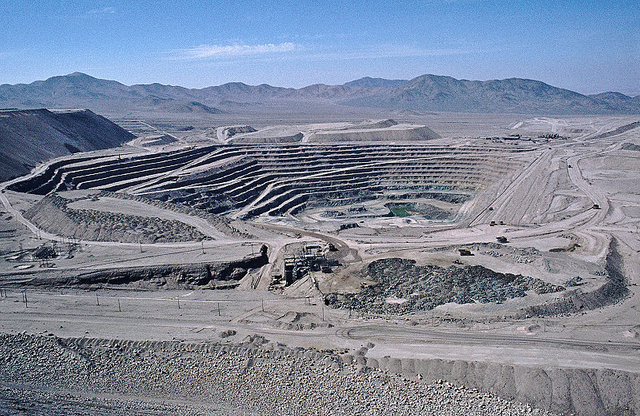
A copper mine in the Atacama. [Image source]
Bibliography:
https://en.wikipedia.org/wiki/Atacama_Desert
https://en.wikipedia.org/wiki/Laguna_Verde_(lake_of_Chile)
https://en.wikipedia.org/wiki/Salt_lake
https://en.wikipedia.org/wiki/Lomas
http://www.antwiki.org/wiki/Solenopsis_gayi
http://www.antwiki.org/wiki/Camponotus_morosus
Ant assemblages at their dry limits: the northern Atacama Desert, Peru, and the Chott El Djerid, Tunisia, by Harold Heatwole
I know you gave all the geology- oceanology-and-meteorology reasons why this should happen, but it still is hard to imagine a place like this up next to a seacoast. Every coast I've lived on or been on was chockful of humidity, fog, rain and low-hanging clouds. To say it's even more inhospitable than Death Valley or the Sahara makes it pretty special ... and not for good reasons. It will be interesting to keep up with the rest of your series. Love the concept!
This excellent post was included in our new curation effort The Magnificent Seven -- a collaborative work by @enchantedspirit and @catweasel. You have received a 100% upvote from each of us to show our appreciation for your post. To see your creation showcased here ... and the fine company you keep ... please visit this link.
We appreciate your support both for our work on this project and for the other creators of exceptional content who make it all possible. (Follow @catweasel to catch our future Magnificent Seven posts. He's really not as annoying as you might think. <--- He always makes me say that.)
Well, the lomas, the hilly regions watered by the sea fog, are actually much more lush than the rest of the Atacama- but the fogs don't penetrate very far.
Very nice post! I am wondering about how the desert is affected by global warming. Do you know, by any chance, how the climate has changed (if it has) over the last couples of decades?
You know what, I actually don't! I actually did a little research in response to this question, and couldn't find much- however, it is something of a hotbed for research on adapting to and surviving climate change.
Sorry to read that. As you said, this consists probably of a very present topic of research. I guess information will become available soon or later. We just need to be patient ;)
I'm so bad at being patient, though!
Same for me. But when one needs 25 year to design an experiment that needs 25 years to be built and an extra 25 years to be exploited.... one becomes patient ;)
That would do the trick, alright!
Friends of mine went here a few years back and were stunned by the raw beauty of the place. For me, deserts are massively under-rated.
I saw a documentary on the Atacama once, and it showed a system where nets are strung between poles on the mountainsides. The fog condenses on the nets, is caught by guttering beneath, and then channeled down to the villagers to use. Ingenious and simple.
I love the desert so much- it's where so much of my heart really dwells.
And that's a super cool msthod of gathering water!
I might not want to live there, but I would love to see this salty lakes with my own eyes. Deadly but beautiful! Thanks for this excursion!
I'd love to visit the Atacama someday, just to say that I'd been!
I saw photograph and i went to drink water. I started to sweat :(
I drank a LOT of water writing this post.
interesting piece of geographical description. I first heard about Atacama desert in my high school geography. Now I know more about it. Thanks
Thanks for reading!
@originalworks
The @OriginalWorks bot has determined this post by @mountainwashere to be original material and upvoted it!
To call @OriginalWorks, simply reply to any post with @originalworks or !originalworks in your message!
Your Post Has Been Featured on @Resteemable!
Feature any Steemit post using resteemit.com!
How It Works:
1. Take Any Steemit URL
2. Erase
https://3. Type
reGet Featured Instantly – Featured Posts are voted every 2.4hrs
Join the Curation Team Here